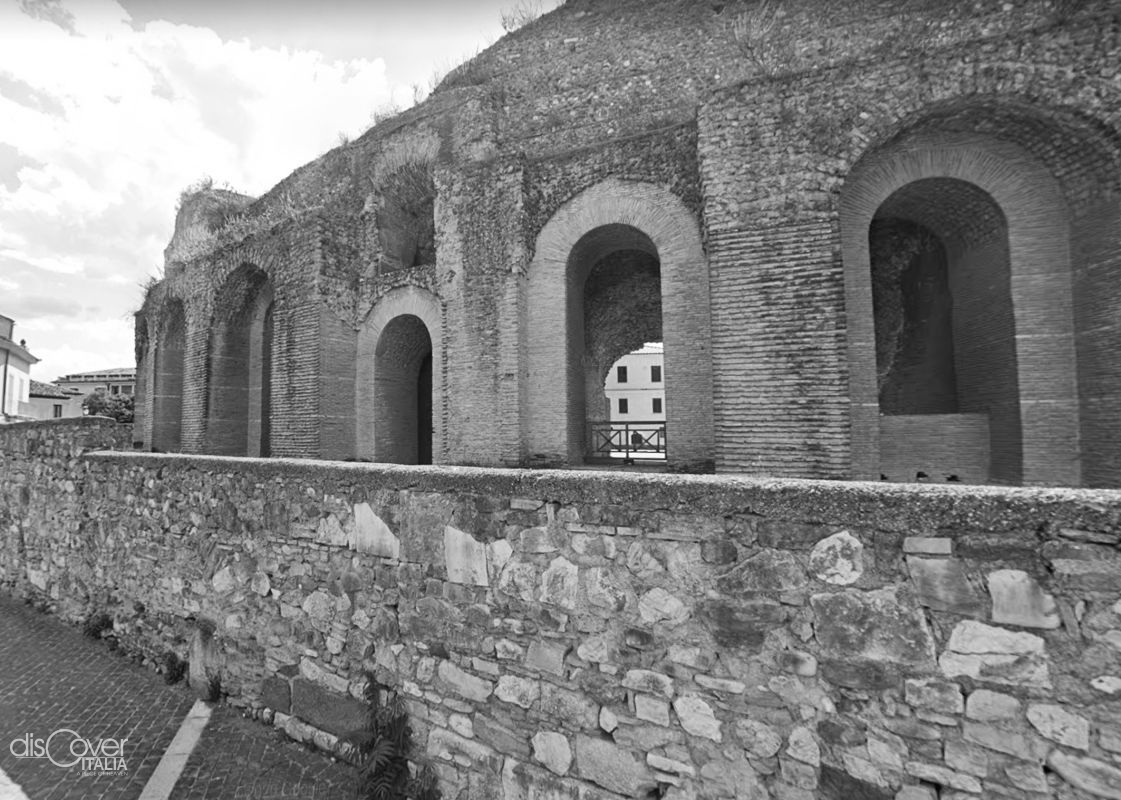The Leproso bridge over the Sabato river is the pedestrian access to the city. In the immediate vicinity are the Cryptoporticus and the remains of the Roman amphitheatre. At a short distance from the amphiteatre, at the intersection at the end of via Torre della Catena, you can see the statue of the Bue Apis (Ox Apis), in pink granite, come to light in 1629, which belonged to the endowment of the temple of Isis, of which there are no traces remaining. It is probably located in the eastern area of the city, since in that area, the majority of the remains were found, attributable to the Isiac cult and currently exhibited in the Egyptian section of the Arcos Museum.
A few steps from the monument, on the San Lorenzo alley, there is the Basilica of Madonna delle Grazie.
Entering in the historic centre from Port’Arsa, the only one remaining from the city’s gates of the Lombard period, when it was built using materials from the Roman age, you can reach piazza Ponzio Telesino, which opens the entrance to the great Roman theatre. On a part of the cavea stands the eighteenth-century church of Santa Maria della Verità, renovated after the seism of 1980.
From via Port’Arsa, in the historic district of Triggio, you can reach via Carlo Torre, corresponding to the Roman cardo maximum. There is the Arch of Sacramento, which maybe introduced the Roman forum. Considerably damaged by the 1943 bombardments, it is part of a visitable archaelogical area. From via Carlo Torre, you arrive corso Garibaldi, which in large part corresponds to the Roman decuman and is a pedestrian area, the heart of Benevento.
On the left stands the Cathedral of Santa Maria de Episcopio, the most ancient church of the city. In front of the Cathedral, in piazza Orsini, there is the eighteenth-century fountain with the statue of Benedict XIII, born Vincenzo Maria Orsini, archbishop of Benevento from 1686 to 1730, who wanted to keep the title of the diocese even after the election to the papal throne. On the right, there was the archiepiscopal palace destroyed by bombings of 1943, which kept precious medieval codes written in the minuscule Benevento. And right next to the cathedral there is the basilica of San Bartolomeo.
Nearby, in piazza Dogana, another jewel is the church of San Francesco with the convent.
On corso Garibaldi, we can see Palazzo Paolo V, with elements of Mannerist architecture on the beautiful façade. Built in 1598 by Giovanni Battista Fontana under request of Paolo Borghese, the future Pope Paul V, it was then enlarged and incorporated the church of Santa Caterina. Municipal seat during the papal domination, it was the first palace in Benevento to have an artificial lighting in 1774. It it home of exhibitions and cultural events.
Immediately after, there is the piazzetta Papiniano, in which there is one of the two obelisks of pink granite (the other one is in the Arcos Museum), of three meters high, coming from the temple of Isis in 88 AD. A hieroglyphic inscription explains that it was built by Rutilio Lupo (who was from Benevento) in honor of Domitian, who requested the temple to be built.
You can also on the corso visit the church of Sant’Anna or Santa Maria del Carmine. Also on the corso, there is Palazzo Mosti, currently the town hall with the characteristic archway over the road to reach the garden, located on the 14th century walls.
Near via Annunziata, there is the church of the same name. From the corso you enter via Traiano, opened after the Second World War precisely to valorise on the background the magnificent Arch of Trajan, symbol of Benevento.
Still in the vicinity, there is the Confraternity of Sant’Antonio Abate and the church with the convent of Sant’Agostino, seat of the University of Samnium with an auditorium.
Returning to corso Garibaldi, you can see several noble palaces such as the eighteenth-century Terragnoli Palace, in Rococo style with the façade by Filippo Raguzzini, seat of the Antonio Mellusi Provincial Library, and then the Vittorio Emanuele municipal theatre, from the middle of the nineteenth century designed by Pasquale Francesconi. Then you get to piazza Santa Sofia, dominated by the church of Santa Sofia, a Unesco Heritage site, housing part of the Samnium Museum in the adjoining convent.
Once you cross corso Garibaldi, you reach via Tenente Pellegrini, where since 1230 is the convent of San Domenico, founded in 1230 to which in 1233 with the church of the same name. The complex houses the Rectorate of the university and, in the side garden of the convent, the Hortus conclusus created by Mimmo Paladino.














Comments powered by CComment